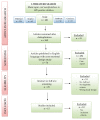Oral Manifestations in HIV-Positive Children: A Systematic Review
- PMID: 32023908
- PMCID: PMC7168689
- DOI: 10.3390/pathogens9020088
Oral Manifestations in HIV-Positive Children: A Systematic Review
Abstract
Background: The number of pediatric patients affected by HIV still remains high, mainly in developing countries, where the main cause of infection is vertical transmission from the mother. Even today, a large number of these children do not have access to treatment, and, without proper care, they die in the first few years of life. Objective: The aim of our review was to assess the prevalence of oral hard and soft tissue lesions in HIV-positive pediatric patients by identifying the most common manifestations and the overall impact that they may have on the children's quality of life. Study design: A systematic review of the articles in the English language in PubMed and Scopus was conducted in March 2019 in order to identify the main epidemiological and cross-sectional studies on the topic. Results: Oral diseases are still one of the most common manifestations in HIV-positive pediatric patients, and they often represent the first form in which immunosuppression shows itself. An analysis of the literature shows that candidiasis is the most common oral lesion found in HIV-positive children. A significant incidence of gingivitis and gingival disease is also evident, though not strictly correlated to HIV infection. However, thanks to the introduction of new antiretroviral therapies, the incidence of HIV-related oral lesions is decreasing. Conclusions: An HIV-positive children care program should also include dental protocols, as oral disease negatively influences the quality of life, affecting both functional and social aspects.
Keywords: AIDS; HIV; children; highly active antiretroviral therapy; oral diseases.
Conflict of interest statement
The authors declare no conflict of interest.
Figures
References
-
- The Joint United Nations Programme on HIV/AIDS (UNAIDS) (2018) UNAIDS Data 2018. [(accessed on 16 January 2019)]; Available online: www.unaids.org/en/resources/documents/2018/unaids-data-2018.
-
- Koyio L., Ranganathan K., Kattappagari K.K., Williams D.M., Robinson P.G. Oral health needs assessment world-wide in relation to HIV. Themes: Oral health needs and inequalities, oral health promotion, co-ordinating research and enhancing dissemination in relation to HIV. A workshop report. Oral Dis. 2016;22:199–205. doi: 10.1111/odi.12433. - DOI - PubMed


